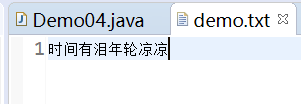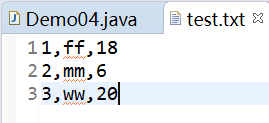一、引入
Case 1:
把ArrayList集合中的字符串数据存储到文本文件中
public class Demo04 {
public static void main(String[] args) {
//创建集合
List<String> list = new ArrayList<String>();
//加入元素
list.add("时间有泪");
list.add("年轮");
list.add("凉凉");
BufferedWriter bw = null;
try {
bw = new BufferedWriter(
new OutputStreamWriter(
new FileOutputStream("demo.txt")));
//遍历集合
for(String str:list) {
bw.write(str);
}
System.out.println("写入成功");
} catch (IOException e) {
e.printStackTrace();
} finally {
if(bw != null) {
try {
bw.close();
} catch (IOException e) {
e.printStackTrace();
}
}
}
}
}
控制台显示:

Case 2:
读取test.txt里面的学生数据,并存入到集合中去
test.txt文件的内容为(事先存好):

public class Demo04 {
public static void main(String[] args) {
List<Student> list = new ArrayList<Student>();
//开始读取数据
BufferedReader br = null;
try {
br = new BufferedReader(
new InputStreamReader(
new FileInputStream("test.txt")));
String str = null;
while((str = br.readLine())!=null) {
String[] ss = str.split(",");//用,来拆分字符串
Student s = new Student(ss[0],ss[1],ss[2]);
list.add(s);
}
System.out.println("存储完毕");
System.out.println(list);
} catch (IOException e) {
e.printStackTrace();
} finally {
if(br != null) {
try {
br.close();
} catch (IOException e) {
e.printStackTrace();
}
}
}
}
}
class Student{
//序号
private String num;
//姓名
private String name;
//年龄
private String age;
/**
* 有参构造方法
*/
public Student(String num, String name, String age) {
super();
this.num = num;
this.name = name;
this.age = age;
}
public String getNum() {
return num;
}
public void setNum(String num) {
this.num = num;
}
public String getName() {
return name;
}
public void setName(String name) {
this.name = name;
}
public String getAge() {
return age;
}
public void setAge(String age) {
this.age = age;
}
@Override
public String toString() {
return "Student [num=" + num + ", name=" + name + ", age=" + age + "]";
}
}
控制台显示:

那么:
当我们想将程序中的对象存储到文件中,该用什么方法?
answer:要用到序列化与反序列化的知识。
二、对象的序列化与反序列化概述
定义:
序列化:将对象转换成方便传输的流(存到文件中)
反序列化:将流转换成对象(可以在程序中操作对象)
注意:
需要传输的对象对应的实体类必须实现
implements Serializable接口
Serializable接口中没有属性及方法,它就相当于一个标志,如果一个实体类实现了它,就可以进行序列化与反序列化。
如果没有实现该接口,则会有java.io.NotSerializableException异常。
使用方法:
序列化:ObjectOutputStream(流)
使用:writeObject(obj):将obj对象序列化到流中
反序列化:ObjecIntputStream(流)
使用:readObject():将流中的对象反序列化成对象
三、序列化与反序列化(初步)
只序列化一个对象到文件中,以及反序列化回到程序来。
1、序列化:
public class Demo05 {
public static void main(String[] args) {
//要存入的对象
Person p = new Person("666@qq.com","123456","ff");
//创建流
ObjectOutputStream oos = null;
try {
oos = new ObjectOutputStream(
new FileOutputStream("test.txt"));
oos.writeObject(p);
System.out.println("序列化成功!");
} catch (IOException e) {
e.printStackTrace();
} finally {
if(oos != null) {
try {
oos.close();
} catch (IOException e) {
e.printStackTrace();
}
}
}
}
}
class Person implements Serializable{
/**
* 序列化的ID,是User对象被序列化之后的唯一标识
* 还有另外一种生成方式。
*/
private static final long serialVersionUID = 1L;
private String email;
private String pwd;
private String name;
public Person(String email, String pwd, String name) {
super();
this.email = email;
this.pwd = pwd;
this.name = name;
}
@Override
public String toString() {
return "Person [email=" + email + ", pwd=" + pwd + ", name=" + name + "]";
}
public String getEmail() {
return email;
}
public void setEmail(String email) {
this.email = email;
}
public String getPwd() {
return pwd;
}
public void setPwd(String pwd) {
this.pwd = pwd;
}
public String getName() {
return name;
}
public void setName(String name) {
this.name = name;
}
}
控制台显示:

2、反序列化
基于进行上述序列化操作后的文件,再进行反序列化。
public class Demo05 {
public static void main(String[] args) {
//创建流
ObjectInputStream ois = null;
try {
ois = new ObjectInputStream(
new FileInputStream("test.txt"));
Person p = (Person) ois.readObject();
System.out.println(p);
} catch (Exception e) {
e.printStackTrace();
}finally {
if(ois != null) {
try {
ois.close();
} catch (IOException e) {
e.printStackTrace();
}
}
}
}
}
控制台显示:

PS:
反序列化时可能会遇到:java.io.EOFException:当读取过程中意外读取到文件或流的末尾时,End Of File。
四、引申
当我将输入流设置为追加,运行多次,在文件中存储对应个数的对象,此时我的序列化与反序列化还能否实现。
(以两个对象的序列与反序列化为例)
public class Demo05 {
public static void main(String[] args) {
//要存入的对象
Person p = new Person("666@qq.com","123456","ff");
//创建流
ObjectOutputStream oos = null;
try {
//第一处修改:
oos = new ObjectOutputStream(
new FileOutputStream("test.txt",true));
oos.writeObject(p);
System.out.println("序列化成功!");
} catch (IOException e) {
e.printStackTrace();
} finally {
if(oos != null) {
try {
oos.close();
} catch (IOException e) {
e.printStackTrace();
}
}
}
//创建流
ObjectInputStream ois = null;
try {
ois = new ObjectInputStream(
new FileInputStream("test.txt"));
Person p1 = (Person) ois.readObject();
System.out.println(p1);
//第二处修改:
Person p2 = (Person) ois.readObject();
System.out.println(p2);
} catch (Exception e) {
e.printStackTrace();
}finally {
if(ois != null) {
try {
ois.close();
} catch (IOException e) {
e.printStackTrace();
}
}
}
}
}
class Person implements Serializable{
/**
* 序列化的ID,是User对象被序列化之后的唯一标识
* 还有另外一种生成方式。
*/
private static final long serialVersionUID = 1L;
private String email;
private String pwd;
private String name;
public Person(String email, String pwd, String name) {
super();
this.email = email;
this.pwd = pwd;
this.name = name;
}
@Override
public String toString() {
return "Person [email=" + email + ", pwd=" + pwd + ", name=" + name + "]";
}
public String getEmail() {
return email;
}
public void setEmail(String email) {
this.email = email;
}
public String getPwd() {
return pwd;
}
public void setPwd(String pwd) {
this.pwd = pwd;
}
public String getName() {
return name;
}
public void setName(String name) {
this.name = name;
}
}
出现异常:

分析:
1、java.io.StreamCorruptedException: invalid type code: AC 无效代码。
2、序列化时,每次调用writeObject()方法写入对象,都会先调用 writeStreamHeader() 这个方法,从而在文件中写入头标记。但是在一个文件中有一个头标记即可,有多个头标记读取第二个对象是会报java.io.StreamCorruptedException: invalid type code: AC 异常。
3、解决方法:
进行文件中第一个对象的序列化时,加上头标记。
后面的对象则不用加。
如果不是第一次写入文件就用自己创建的子类Sub写入对象,就不会写入头标记。
五、有多个对象的序列及反序列化
(1)序列化:
public class Sub extends ObjectOutputStream{
//此处要注意
public Sub(OutputStream out) throws IOException {
super(out);
}
//重写writeStreamHeader,则使用此类创建的对象不会自动加上头标记
@Override
protected void writeStreamHeader() throws IOException {
//super.writeStreamHeader();
}
}
public class Demo05 {
public static void main(String[] args) {
ObjectOutputStream oos = null;
FileOutputStream fos = null;
try {
//创建文件对象
File file = new File("text.txt");
//创建字节输出流
fos = new FileOutputStream(file,true);//允许追加
if(file.length() < 1) {//如果文件长度为空
System.out.println("111");
oos = new ObjectOutputStream(fos);
System.out.println(oos);
}else {//用自定义的类去创建对象
System.out.println("222");
oos = new Sub(fos);
System.out.println(oos);
}
//要存入的对象
Person p = new Person("666@qq.com","123456","ff");
oos.writeObject(p);
System.out.println("序列化成功!");
} catch (IOException e) {
e.printStackTrace();
} finally {
if(oos != null) {
try {
oos.close();
} catch (IOException e) {
e.printStackTrace();
}
}
if(fos != null) {
try {
fos.close();
} catch (IOException e) {
e.printStackTrace();
}
}
}
}
}
class Person implements Serializable{
private static final long serialVersionUID = 1L;
private String email;
private String pwd;
private String name;
public Person(String email, String pwd, String name) {
super();
this.email = email;
this.pwd = pwd;
this.name = name;
}
@Override
public String toString() {
return "Person [email=" + email + ", pwd=" + pwd + ", name=" + name + "]";
}
public String getEmail() {
return email;
}
public void setEmail(String email) {
this.email = email;
}
public String getPwd() {
return pwd;
}
public void setPwd(String pwd) {
this.pwd = pwd;
}
public String getName() {
return name;
}
public void setName(String name) {
this.name = name;
}
}
文件显示:

(2)反序列化
自定义异常,当读取到文件末尾时。
public class Demo06 {
public static void main(String[] args) {
ObjectInputStream ois = null;
try {
ois = new ObjectInputStream(
new FileInputStream("text.txt"));
try {
Object obj = null;
while((obj = ois.readObject())!=null) {
Person p = (Person)obj;
System.out.println(p);
}
}catch(EOFException e) {//当文件读取到末尾,自定义异常
System.out.println("已读取完毕");
}
} catch (Exception e) {
e.printStackTrace();
}
}
}





















 967
967











 被折叠的 条评论
为什么被折叠?
被折叠的 条评论
为什么被折叠?








